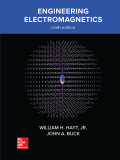
Engineering Electromagnetics
9th Edition
ISBN: 9781260029963
Author: Hayt
Publisher: MCG
expand_more
expand_more
format_list_bulleted
Concept explainers
Question
Chapter 6, Problem 6.44P
To determine
(a)
The maximum electric field intensity
To determine
(b)
The spherical coordinate
Expert Solution & Answer
Want to see the full answer?
Check out a sample textbook solution
Students have asked these similar questions
A 2000 kVA,Y- connected alternator gives an open circuit line voltage of 3.3 kV for a field current of
65 A. For same field current the short circuit current is being equal to full load current. Calculate the full
load voltage regulation at both 0.8 lagging p.f. and unity p.f., neglect armature resistance?
Don't use ai to answer I will report you answer
Don't use ai to answer I will report you answer
Chapter 6 Solutions
Engineering Electromagnetics
Ch. 6 - Prob. 6.1PCh. 6 - Let S = 100 mm2. d= 3 mm, and er = 12 for a...Ch. 6 - Capacitors tend to be more expensive as their...Ch. 6 - Prob. 6.4PCh. 6 - Prob. 6.5PCh. 6 - A parallel-plane capacitor is made using two...Ch. 6 - For the capacitor of Problem 6.6, consider the...Ch. 6 - Prob. 6.8PCh. 6 - Prob. 6.9PCh. 6 - A coaxial cable has conductor dimensions of a =...
Ch. 6 - Prob. 6.11PCh. 6 - (a) Determine the capacitance of an isolated...Ch. 6 - With reference to Figure 6.5, let b=6m, h=15m, and...Ch. 6 - Two=16 copper conductor (1.29 mm diameter) are...Ch. 6 - Prob. 6.15PCh. 6 - Prob. 6.16PCh. 6 - Construct a curvilinear-square map for a coaxial...Ch. 6 - Prob. 6.18PCh. 6 - Construct a curvilinear- square map of the...Ch. 6 - Prob. 6.20PCh. 6 - The inner conductor of the transmission line shown...Ch. 6 - Prob. 6.22PCh. 6 - Prob. 6.23PCh. 6 - A potential field in free space is given in...Ch. 6 - A capacitor is formed from concentric spherical...Ch. 6 - Given the spherical symmetric field in free space,...Ch. 6 - Let V=z(x,y)=4e2xf(x)3y2 in a region of free space...Ch. 6 - Show that in a homogeneous medium of conductivity...Ch. 6 - What total charge must be located within a unit...Ch. 6 - Prob. 6.30PCh. 6 - For the parallel-plate capacitor shown in Figure...Ch. 6 - Prob. 6.32PCh. 6 - The functions V1 (p, , z) and V2(p, , z) both...Ch. 6 - Prob. 6.34PCh. 6 - Prob. 6.35PCh. 6 - Prob. 6.36PCh. 6 - Prob. 6.37PCh. 6 - Prob. 6.38PCh. 6 - Prob. 6.39PCh. 6 - Prob. 6.40PCh. 6 - Prob. 6.41PCh. 6 - Prob. 6.42PCh. 6 - Prob. 6.43PCh. 6 - Prob. 6.44PCh. 6 - Prob. 6.45PCh. 6 - By appropriate solution of Laplaces and Poissons...
Knowledge Booster
Learn more about
Need a deep-dive on the concept behind this application? Look no further. Learn more about this topic, electrical-engineering and related others by exploring similar questions and additional content below.Similar questions
- What is motorarrow_forwardDon't use ai to answer I will report you answerarrow_forwardHow can I design a socket for a trolley headlight? What parameters should I measure? The only thing I have is the headlight itself, and I don’t have any information about its power, current, or voltage rating. The power source is 120 V, and my goal is simply to get the headlight to turn on.I’m not sure where to start or what to measure. Any recommendations would be greatly appreciated!arrow_forward
- Figure 2 3) *** The circuit of Figure 3 is designed with W/L = 20/0.18, λ= 0, and ID = 0.25 mA. (Optional- 20 points) a) Compute the required gate bias voltage. b) With such a gate voltage, how much can W/L be increased while M1 remains in saturation? What is the maximum voltage gain that can be achieved as W/L increases? VDD = 1.8 V RD 2k - Vout Vin M₁ Figure 3arrow_forward1) Rs = 4kQ, R₁ = 850 kQ, R₂ = 350 kQ, and R₁ = 4 kQ. The transistor parameters are VTP = -12 V, K'p = 40 µA / V², W/L = 80, and λ = 0.05 V-1. (50 Points) a) Determine IDQ and VSDQ. b) Find the small signal voltage gain. (Av) c) Determine the small signal circuit transconductance gain. (Ag = io/vi) d) Find the small signal output resistance. VDD = 10 V 2'; www www Figure 1 Ссarrow_forwardQ11arrow_forward
arrow_back_ios
SEE MORE QUESTIONS
arrow_forward_ios
Recommended textbooks for you
 Introductory Circuit Analysis (13th Edition)Electrical EngineeringISBN:9780133923605Author:Robert L. BoylestadPublisher:PEARSON
Introductory Circuit Analysis (13th Edition)Electrical EngineeringISBN:9780133923605Author:Robert L. BoylestadPublisher:PEARSON Delmar's Standard Textbook Of ElectricityElectrical EngineeringISBN:9781337900348Author:Stephen L. HermanPublisher:Cengage Learning
Delmar's Standard Textbook Of ElectricityElectrical EngineeringISBN:9781337900348Author:Stephen L. HermanPublisher:Cengage Learning Programmable Logic ControllersElectrical EngineeringISBN:9780073373843Author:Frank D. PetruzellaPublisher:McGraw-Hill Education
Programmable Logic ControllersElectrical EngineeringISBN:9780073373843Author:Frank D. PetruzellaPublisher:McGraw-Hill Education Fundamentals of Electric CircuitsElectrical EngineeringISBN:9780078028229Author:Charles K Alexander, Matthew SadikuPublisher:McGraw-Hill Education
Fundamentals of Electric CircuitsElectrical EngineeringISBN:9780078028229Author:Charles K Alexander, Matthew SadikuPublisher:McGraw-Hill Education Electric Circuits. (11th Edition)Electrical EngineeringISBN:9780134746968Author:James W. Nilsson, Susan RiedelPublisher:PEARSON
Electric Circuits. (11th Edition)Electrical EngineeringISBN:9780134746968Author:James W. Nilsson, Susan RiedelPublisher:PEARSON Engineering ElectromagneticsElectrical EngineeringISBN:9780078028151Author:Hayt, William H. (william Hart), Jr, BUCK, John A.Publisher:Mcgraw-hill Education,
Engineering ElectromagneticsElectrical EngineeringISBN:9780078028151Author:Hayt, William H. (william Hart), Jr, BUCK, John A.Publisher:Mcgraw-hill Education,

Introductory Circuit Analysis (13th Edition)
Electrical Engineering
ISBN:9780133923605
Author:Robert L. Boylestad
Publisher:PEARSON

Delmar's Standard Textbook Of Electricity
Electrical Engineering
ISBN:9781337900348
Author:Stephen L. Herman
Publisher:Cengage Learning

Programmable Logic Controllers
Electrical Engineering
ISBN:9780073373843
Author:Frank D. Petruzella
Publisher:McGraw-Hill Education

Fundamentals of Electric Circuits
Electrical Engineering
ISBN:9780078028229
Author:Charles K Alexander, Matthew Sadiku
Publisher:McGraw-Hill Education

Electric Circuits. (11th Edition)
Electrical Engineering
ISBN:9780134746968
Author:James W. Nilsson, Susan Riedel
Publisher:PEARSON

Engineering Electromagnetics
Electrical Engineering
ISBN:9780078028151
Author:Hayt, William H. (william Hart), Jr, BUCK, John A.
Publisher:Mcgraw-hill Education,
Electric Charge and Electric Fields; Author: Professor Dave Explains;https://www.youtube.com/watch?v=VFbyDCG_j18;License: Standard Youtube License